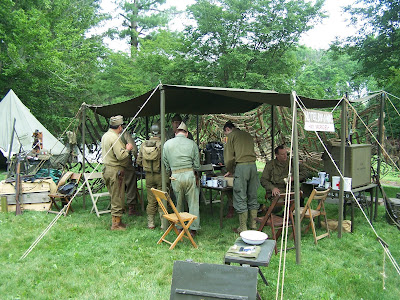
This past month at Eisenhower National Historic Site in Gettysburg hosted a commemoration event for the 66th anniversary of the Normandy landings in Northern France. According to the United States Army History of the invasion, "June 6, 1944, 160,000 Allied troops landed along a 50-mile stretch of heavily-fortified French coastline to fight Nazi Germany on the beaches of Normandy, France. General Dwight D. Eisenhower called the operation a crusade in which “we will accept nothing less than full victory.” More than 5,000 Ships and 13,000 aircraft supported the D-Day invasion, and by day’s end on June 6, the Allies gained a foot- hold in Normandy. The D-Day cost was high -more than 9,000 Allied Soldiers were killed or wounded -- but more than 100,000 Soldiers began the march across Europe to defeat Hitler."
This particular Living History event was held on the grounds of the Eisenhower Farm, purchased by Ike and Mamie in 1950. Eisenhower first lived on the battlefield while commandant of Camp Colt during WWI. During the Second World War, the battlefield was home to both Camp Sharpe Prison Camp (see article) and a training center for GIs. These are some little known tidbits regarding the battlefield. The D-Day event at Ike's pales in comparison in relation to the World War II Weekend the site hosts every September. I hope to attend this weekend-long event which includes speakers, demonstrations, and period vehicles.
This particular Living History event was held on the grounds of the Eisenhower Farm, purchased by Ike and Mamie in 1950. Eisenhower first lived on the battlefield while commandant of Camp Colt during WWI. During the Second World War, the battlefield was home to both Camp Sharpe Prison Camp (see article) and a training center for GIs. These are some little known tidbits regarding the battlefield. The D-Day event at Ike's pales in comparison in relation to the World War II Weekend the site hosts every September. I hope to attend this weekend-long event which includes speakers, demonstrations, and period vehicles.
Enjoy this eight minute video produced by the Army which includes archival footage of the campaign and interviews by veterans who saw it firsthand.

The day began at the park visitor center, where friend and historian John Heiser parked his original WWII Ford GPW at the plaza of the museum to promote the event at Ike's that day. John and several within his reenacting unit restored this unique vehicle after much neglect brought about by previous owners. It's now back to it's former glory.

While walking back from my Pickett's Charge tour, this (what I think is a) 1941 PT-17 Stearman bi-plane flew over the High Water Mark. It was likely flying toward the Reading WWII Air Show also taking place that weekend.

At the farm itself, two small companies of arrayed American troops in addition to British Commandos were encamped on the farm's grounds.

This infantryman was beginning to back up his gear, which included his pack, M1 Rifle, ration kit, and baseball mitt.

This GI is sporting a Water Proof M7 Gas Mask bag on his chest. These were designed specifically for the invasion of Europe. These would often be discarded by the troops. Other items such as gas brassard, a green armband worn on the left arm which would turn pink if poison gas were introduced.

The Thompson sub-machine gun at left was a common weapon of choice by Allied troops. It was ideal for both close quarter and urban combat. Devised shortly after the end of the First World War, it was known as the "gangster's weapon" during Prohibition until it was put to great and effective use during WWII. Also seen here are varying types of field explosives, grenades, and detonators.

This display of American small arms included two bolt-action rifles (one with a sniper's scope). Also seen here is the trusted M1 Garand Rifle, which fired from an around round clip in the weapon's rear breach. Upon firing all the weapon's rounds, the clip would automatically eject, making a "ping" sound. It weighed about 9.5 pounds, similar in heft to muskets of the Civil War era.


A very accurate portrayal of common, everyday items distributed to British soldiers can be seen via this photo. Included here are weaponry components, rations, and miscellaneous medical supplies and equipment.
This commando is holding a Lee-Enfield Mark IV rifle. This bolt-action weapon was the primary rifle used by British troops during the Second World War. This weapon and its very similar predecessor have been used by the Brits for over 100 years. I suppose the old saying, "If it ain't broke, don't fix it," applies here. During and before the war, many of these were produced in the U.S. in order to assist the pressured British Military.

Living History everyday here in Gettysburg. (Okay, this is me from the town's Memorial Day Parade.) I'd like to thank all those reenactors who made this event possible and the dedicated staff of Eisenhower National Historic Site for putting on a good show. Through events like this, the average visitor receives a true immersion experience.




No comments:
Post a Comment